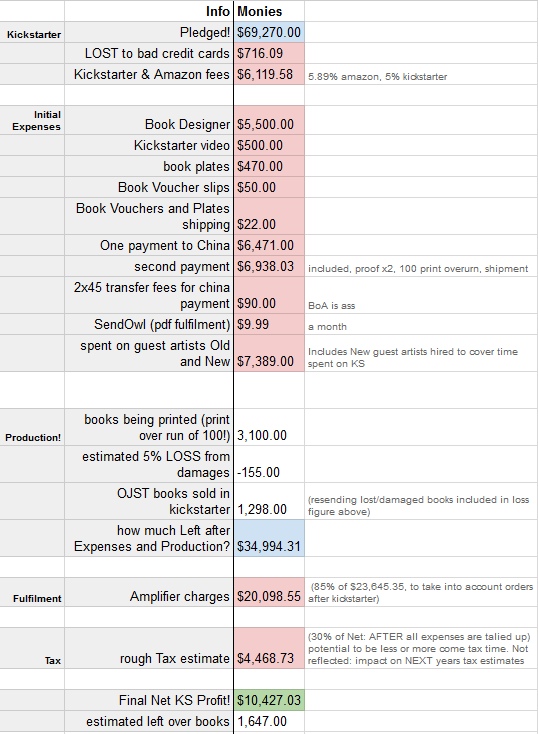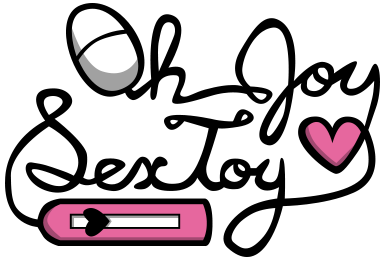
-Edited (see very bottom, for additional transparency!)
Hi everybody, we’ve finally received our last invoice for our May Kickstarter, which means we can finally give you folks some numbers on our successful fundraising campaign.
This sort of stuff probably isn’t going to be interesting to many of you. But we love numbers, planning and Kickstarters. So if you’re like us and are into numbers, or plan to do a Kickstarter, this might be relevant to you. I’ll be covering a bunch of the Kickstarter planning that went into the project and some of our thinking along the way.
tl;dr We raised $69k and profited about $10k from it.
Here’s our cost breakdowns.

Read on below for a much more in-depth analysis of our experiences.
Our Kickstarter Aim
We wanted to raise enough cash to print out 2,000 fancy Oh Joy Sex Toy volumes of the first year’s work and bump our guest artist pay rate up retroactively. For this we wanted to do a low-impact campaign that would serve alongside our current jobs instead of replacing them.
The Planning
We sat down to plan our Kickstarter in January (a full 5 months before we intended it to go live), at this point we had already created 50% of the final book design, paying out of pocket for book designer Allyson Haller ($5,500 spread over 6 months), contacting our shipping company of choice, and started conversations with our video guru Anne Moloney, and book plate printer. We wanted to be sure to have the book designed and ready to send to the printers as soon as the fundraiser closed, with ample padding time in case anything went badly. We also wanted to fast track the reward-shipping process with an aim to have the book in people’s hands within 6 months of completion. We worried that anything more and the project would go past the point of being profitable in regards to time invested.
Our very first meeting we sat down and jotted down exactly what we wanted to get out of the project and what we would want backers to get out of it. We both sat in the yard throwing out ideas and then chopping the idea up into cost and time, then inflating both numbers by about 15% because nothing happens perfectly. It didn’t take us long to figure out that we didn’t have time to do any kind of extravagant Kickstarter with numerous bonus items on offer to help promote sales. Erika was working full time on OJST and I was working full time as a UX designer, the only time we could dedicate to the project would be 4 weeks of guest strips (which would end up costing us $1,980, plus time to organize) and my after-hours. So the time and resources needed to get this done was limited.
Deciding on a ‘Just-Producing-the-Book’ Kickstarter was the smartest thing we did for the project. It’s incredibly easy to add more products to your project to encourage fundraising and it’s incredibly difficult to actually add them to your production. Real life goods need creating, maintaining, inventory management and shipping. Every item added hugely complicates the process. From chats with other creators we decided that the time investment just wasn’t worth it.
We settled on different book plates (signed, doodled, custom), selling some original pages and the books + pdf + wallpaper, and a ‘Be a Masturbateer for a Day’ option we wanted to trial run (for potential sale later).
Once we had decided what was attainable within our timeline we set up schedules for each piece of the project and cracked on.
Our money
Coming up with broad cost estimates to see if the project would be successful (in this instance, meaning it would produce more than the minimum wage for time invested) was one of the hardest parts. We had a broad sense of how many books might sell over the year (using Erika’s previous DAR! books as a basis) but it wasn’t an accurate model since OJST was brand new and more popular. Different quotes from different companies would widely change the outcome, meaning I had to pad a lot of the numbers with large buffers (I went full conservative by adding 20% to everything). It also didn’t help that the book’s page count (and therefore weight) kept climbing as Erika added more awesome stuff.
We had heard horror stories about Kickstarter self-fulfillment, so it was also decided early on to find a fulfillment company to deal with the orders. It was an expensive option that would help shoulder that work load so we wouldn’t have to take time away from our jobs to do it ourselves.
With all that in mind, one thing became clear early on: at $35 per kickstarter book, a price that includes domestic shipping, we would end up making less than $8 per book, if we pre-sold all 2000. Not ideal for the time invested. Still we kept on, hoping the prices of production would be less than my padded estimates and the campaign would do well.
The process
Everything went smoothly the first few months. The only real hardships being the payment we had to send to the book designer out of pocket. We settled on Amplifer as a fulfillment company after getting the recommendation from George Rohac. The quotes seemed reasonable but confusing, with the contract being 5 pages long. It didn’t help with my estimates, so I broadly and foolishly decided that shipping would be an-averaged-out $12 per book (4ish dollars more than a good USPS quote) and we would just have to eat that fee, as we didn’t feel like we could ask for more than $35-per-book on Kickstarter.
Setting a fundraising goal proved difficult. We didn’t want to ask for our golden number of $30k-ish, which would have all payments balanced out, as a large number for a seemingly-simple product can be unappealing to potential backers. So we settled at $18k, knowing we would have to pay even more out of pocket if it didn’t make more. It seemed riskier but a more reachable goal. Stretch goals also seemed unappealing: we didn’t want to produce MORE products, we just wanted MORE pre-sales of our one product. Our answer was to turn the guest artist retro-payment into a rolling tier. It would help lower our potential costs if the Kickstarter did poorly, while still ensuring our guest artists received their promised increased back-dated page rates. Additionally the retro-payments would help boost our campaign as the artists would hopefully promote us to to their own audiences. It also gave us something to publicize once our initial goal had already been met.
With regards to delivery dates we padded out our estimates by about 20%. Books would PROBABLY be printed and arrive by September but we tacked on 2 more months to cover problems, quoting book delivery in November.
Time spent in communication with different companies ended up being greater than my estimates, so I ended up adjusting our forecasts. For about six months leading up to the fundraiser’s launch, we were sacrificing to pay for the book’s pre-production out of pocket. Our day to day finances felt very tight.
The Kickstarter
We had planned for and expected to earn $30-40k and surprisingly ended up getting a fantastic $69,270. It had been a success! We now had 1,300ish pre-orders of the books! We decided to increase our print run from 2,000 copies to 3,000, which helped lower the cost per book but increased the initial down payment to the printer. No biggy though, we wanted to have extra stock after the pre-orders were fulfilled as these bonus books we could sell at $30 (which doesn’t include shipping) would be a greater profit for us than the pre-order sales of $35 per book (which does include a massively under valued rate for shipping). Our guest artist rate hit $99 a page (up from $50), and we where now on the hook to produce some books!
We put in the order with our printers, and the books where estimated for late September arrival at Amplifier.
We hit some bumps with Amazon payments but it didn’t delay us more than a week or two.
6 Months Later
Our kickstarter went smashingly. We didn’t really hit any major obstacles.
Erika managed to get the book plates signed and drawn within the allocated time frames. Only communicating with the custom bookplate backers took us widely over time-budget, since we had to wait on and chase their responses. We made sure to sign and make 10% more bookplates than needed, just in case we lost stock during shipping.
The books arrived at Amplifier a few weeks late (due to a delay on Amplifier’s end) with few damages: Chinese printers are the best! Amp then spent about 3 weeks setting up the assembly of inserting bookplates into the books. The SKU (inventory tracking system) set-up was a lot more complicated than it aught to have been, but we managed to make it work with some hand-holding from Amplifier and a bunch of phone calls.
Getting people to fill out the backer survey to get their shipping addresses also took time, but we managed to get 92% completion within a month and 96% completion a month later. Having said that, I’m still getting emails from people filling out their surveys 6 months later: crazy!
The books went out earlier than expected and we received an astounding report of only 2 damages out of the 1,300 pre-orders that were sent out to backers. Amplifier went with the more expensive choice of using DHL Shipping to send out the books, meaning less damages but more cost for shipping. We expected shipping (domestical and international combined) to average out to $12 per book, but it ended up being more like $15.50, a massive difference, that in hindsight I can’t say was worth the lack of damages or not.
Once all the pre-orders were en-route to backers, we opened up sales to the general public. A few months later, after experiencing additional hiccups, we decided to move our wares to another fulfillment service. The books are now housed at our home (for conventions and Amazon sales) and at Topatoco (For all other online sales). We took more damages during this process (always expect damages!) but have a good amount left to sell for the rest of the year.
Numberwang breakdown
So where did all this get us? Well here are our numbers!

After all our Kickstarting we managed to pocket $10k profit with 1,600 leftover OJST books to sell and our guest artists getting a bonus $7k! And our wonderful backers ended up received on average a massive $10.50 discount per book (23%!) by backing at $35 compared to a later sold $45.50 book (includes averaged shipping)).
If we do some loose forward projections and sell all of the books we have left, minus our future fulfillment costs, minus some tax, and added to the profit from the Kickstarter income, we aught to walk away from all this with $38k, roughly $12.50 of pocketed profit per book. But this number is subject to change dependent on wholesaling and damages.
If I do some even more savage math and work out time invested just into Kickstarter (not including how long it took to MAKE the year’s worth of OJST pages, but does include estimated future time investment for selling the rest of the stock) we can walk away from here knowing that working on a Kickstarter to print 3,100 books gets you a super rough $23 an hour.
So what does this all mean? Well it means we love Kickstarter, and so should you! We got our books, our fans got theirs, and we got paid!
Lessons
We plan to do another kickstarter next year (every year will be a new volume) and don’t expect next years to do as well as this first year’s did. But that’s OK because we’ll be doing things a tad differently with our new insight.
Here’s a list of things we’re planning to do differently next time:
– We’ll remove even MORE product options from the Kickstarter. No original art, no custom drawings – just the stock sketches that come on bookplates.
– We can probably do the book design ourselves using the first volume as a template, then hiring a book design on a hourly basis for consultation to make sure we haven’t fucked up the files too badly.
– We will consider doing fulfillment ourselves: opting out was a good option when I was busy with another job, but now that I’m full time working on OJST (and have experience warehousing from a previous job in England) we can do that ourselves.
– New stricter time limits on the survey response times: one year is too long wait for people to give us their addresses.
If you made it down here, you’re a star. Here’s a gif, you deserve it.

Additional Transparency
Oh wow, what a response! I didn’t expect you all to be so keen to see our break down. I wanted to address some concerns over our shipping and my statement that it averaged out to $15.50 per Kickstarted book, a response I’ve been hearing is that it’s far too much compared to other shipping. Well this number contains a bunch of things in addition to the base DHL shipping price ($10-$12 USA, $15-20 rest of world). It includes all the fees for the book assembly (paid man hours, adding book plates & vouchers to books), packaging materials & packing time, Amplifier fees, a one-time freight cost (to split our stock from Texas to home in Portland), domestic shipping AND international shipping. It’s not just one fee, but a bunch! To compare it to a USPS price is to exclude the man hours, materials and customer service that this fee encompasses. I wish I could deconstruct this further, but we’re contractually obliged not to discuss the specifics of our Amplifier invoices.
In addition, Amplifer does not have access to ALL the shipping that is available: they are a company in themselves and have negotiated rates with carriers. Our cheapest options through them were UPS Ground and DHL (no options for media mail, or fix rate envelopes through USPS). The options Amplifier had available to us are based on years of fulfillment services, so when they quoted to us their cheapest DHL option we happily accepted.
If it at all helps, our books are also quiet heavy at 2.45lbs with minimum packaging.
Some of you also want to know WHERE can you buy the book? Well it’s Stocked Right Here at Topatoco!
I hope this helps people!



